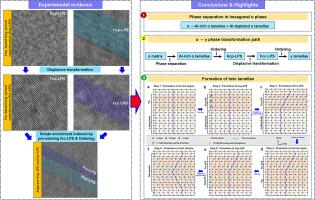Phase separation in hexagonal α phase during lamellar formation of TiAl alloys and its effect on subsequent phase transformations
IF 11.2
1区 材料科学
Q1 MATERIALS SCIENCE, MULTIDISCIPLINARY
引用次数: 0
Abstract
TiAl alloys with the (α2 + γ) lamellar structure are highly valued for their excellent high-temperature strength and creep resistance. Understanding the formation mechanism of the lamellar structure is crucial for tuning the microstructure and properties. This work investigates the formation of lamellar structure in Ti-48Al-7Nb-2.5V-1Cr alloy, revealing the presence of hcp-based long-period superstructure (hcp-LPS) as a metastable phase during lamellar formation. The identification of hcp-LPS demonstrates that the necessary solute enrichment for the formation of γ lamellae occurs on the hexagonal α matrix, implying that phase separation of α → Al-rich α lamellae + Al-depleted α lamellae is the first step of lamellar formation. Once phase separation is completed, all subsequent phase transitions occur within the Al-rich α lamellae. Additionally, the formation of twin lamellae is further discussed. The formation of the twin lamellae occurs sequentially. Pre-existing lamella promotes the formation of later lamella by inducing solute enrichment in its surrounding region, and then the successive slip of Shockley partial dislocations with opposite Burgers vectors ensures special stacking of later lamellae. These findings not only contribute to the fundamental understanding of spinodal mechanisms in hexagonal crystals, but also provide novel insights into the formation of twin lamellae.

钛铝合金薄片形成过程中六方α相的相分离及其对后续相变的影响
具有 (α2 + γ) 层状结构的钛铝合金因其出色的高温强度和抗蠕变性而备受推崇。了解层状结构的形成机理对于调整微观结构和性能至关重要。本研究对 Ti-48Al-7Nb-2.5V-1Cr 合金中薄片结构的形成进行了研究,揭示了薄片形成过程中存在基于 hcp 的长周期超结构(hcp-LPS)这一可转移相。hcp-LPS 的确定表明,γ 片层形成所需的溶质富集发生在六方形的 α 基体上,这意味着 α → 富铝 α 片层 + 贫铝 α 片层的相分离是片层形成的第一步。一旦完成相分离,所有后续的相变都会在富铝α薄片内发生。此外,还进一步讨论了孪生薄片的形成。孪晶薄片的形成是按顺序进行的。先存在的薄片通过诱导其周围区域的溶质富集来促进后薄片的形成,然后具有相反布尔格斯矢量的肖克利部分位错的连续滑移确保了后薄片的特殊堆积。这些发现不仅有助于从根本上理解六方晶体的旋光机制,而且为孪晶薄片的形成提供了新的见解。
本文章由计算机程序翻译,如有差异,请以英文原文为准。
求助全文
约1分钟内获得全文
求助全文
来源期刊

Journal of Materials Science & Technology
工程技术-材料科学:综合
CiteScore
20.00
自引率
11.00%
发文量
995
审稿时长
13 days
期刊介绍:
Journal of Materials Science & Technology strives to promote global collaboration in the field of materials science and technology. It primarily publishes original research papers, invited review articles, letters, research notes, and summaries of scientific achievements. The journal covers a wide range of materials science and technology topics, including metallic materials, inorganic nonmetallic materials, and composite materials.
 求助内容:
求助内容: 应助结果提醒方式:
应助结果提醒方式:


